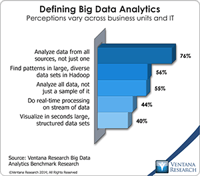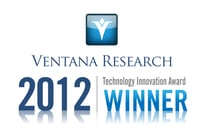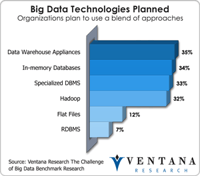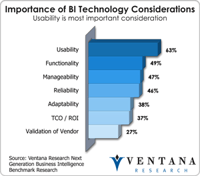Many businesses are close to being overwhelmed by the unceasing growth of data they must process and analyze to find insights that can improve their operations and results. To manage this big data they find a rapidly expanding portfolio of technology products. A significant vendor in this market is SAS Institute. I recently attended the company’s annual analyst summit, Inside Intelligence 2014 (Twitter Hashtag #SASSB). SAS reported more than $3 billion in software revenue for 2013 and is known...
Read More
Topics:
Big Data,
Predictive Analytics,
SAS,
Event Stream,
Operational Performance,
Analytics,
Business Analytics,
Business Intelligence,
Business Performance,
CIO,
Customer & Contact Center,
Data Management,
Information Applications,
Information Management,
Location Intelligence,
Operational Intelligence,
Discovery
With much fanfare and a rarely seen introduction by CEO Ginni Rometty, IBM launched IBM Watson as a new business unit focused on cognitive computing technology and solutions, now being led by Senior Vice President Mike Rhodin. The announcement is summarized here:. Until now IBM Watson was important but had neither this stature in IBM’s organizational structure nor enough investment to support what the company proclaims is the third phase of computing. As IBM tells it, computing paradigms began...
Read More
Topics:
Big Data,
Sales Performance,
Social Media,
Supply Chain Performance,
IT Performance,
Operational Performance,
Analytics,
Business Analytics,
Business Collaboration,
Business Intelligence,
Business Performance,
CIO,
Cloud Computing,
Customer & Contact Center,
Financial Performance,
Governance, Risk & Compliance (GRC),
Information Applications,
Information Management,
Location Intelligence,
Operational Intelligence,
Workforce Performance,
Cognitive Computing,
Discovery,
Exploration,
IBM Watson
Like every large technology corporation today, IBM faces an innovator’s dilemma in at least some of its business. That phrase comes from Clayton Christensen’s seminal work, The Innovator’s Dilemma, originally published in 1997, which documents the dynamics of disruptive markets and their impacts on organizations. Christensen makes the key point that an innovative company can succeed or fail depending on what it does with the cash generated by continuing operations. In the case of IBM, it puts...
Read More
Topics:
Predictive Analytics,
IT Performance,
Analytics,
Business Analytics,
Business Intelligence,
Business Performance,
Customer & Contact Center,
IBM,
Information Applications,
Data Discovery,
Discovery,
Information Discovery,
SPSS
Business analytics can help organizations use data to find insights that lead to new opportunities and address issues unrecognized before. One player in this market is Datawatch, known for its tools for information optimization and harvesting value from big data including content and documents. I assessed the company earlier this year, and recently our firm recognized its customers’ achievements with 2013 Ventana Research Leadership Awards for Information Optimization with Phelps County...
Read More
Topics:
Big Data,
Sales Performance,
SAP,
Supply Chain Performance,
GRC,
Office of Finance,
Panopticon,
Operational Performance,
Analytics,
Business Intelligence,
Business Performance,
Customer & Contact Center,
Financial Performance,
Information Applications,
Information Management,
Operational Intelligence,
CEP,
Datawatch,
Discovery,
Information Optimization,
SAP HANA
Teradata recently gave me a technology update and a peek into the future of its portfolio for big data, information management and business analytics at its annual technology influencer summit. The company continues to innovate and build upon its Teradata 14 releases and its new processing technology. Since my last analysis of Teradata’s big data strategy, it has embraced technologies like Hadoop with its Teradata Aster Appliance, which won our 2012 Technology Innovation Award in Big Data....
Read More
Topics:
Big Data,
MicroStrategy,
SAS,
Tableau,
Teradata,
Customer Excellence,
Operational Performance,
Analytics,
Business Analytics,
Business Intelligence,
CIO,
Cloud Computing,
Customer & Contact Center,
In-Memory Computing,
Information Applications,
Information Management,
Location Intelligence,
Operational Intelligence,
CMO,
Discovery,
Intelligent Memory,
Teradata Aster,
Strata+Hadoop
Business intelligence software is supposed to help businesses access and analyze data and communicate analytics and metrics. I have witnessed improvements to BI software over the years, from mobile and collaboration to interactive discovery and visualization, and our Value Index for Business Intelligence finds a mature set of technology vendors and products. But even as these products mature in capabilities, the majority lack features that would make them easy to use. Our recent research on ...
Read More
Topics:
Big Data,
Sales Performance,
Supply Chain Performance,
Mobile Technology,
Natural Language,
Business Technology Innovation,
IT Performance,
Operational Performance,
Business Analytics,
Business Collaboration,
Business Intelligence,
Business Mobility,
Business Performance,
Cloud Computing,
Customer & Contact Center,
Financial Performance,
Information Management,
Location Intelligence,
Operational Intelligence,
Workforce Performance,
Discovery















